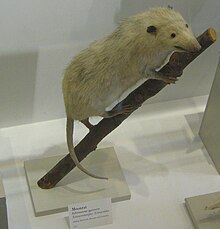Moonrat
| Moonrat | |
|---|---|
 |
|
| Scientific classification | |
| Kingdom: | Animalia |
| Phylum: | Chordata |
| Class: | Mammalia |
| Order: | Eulipotyphla |
| Family: | Erinaceidae |
| Genus: |
Echinosorex Blainville, 1838 |
| Species: | E. gymnura |
| Binomial name | |
|
Echinosorex gymnura (Raffles, 1822) |
|
 |
|
| Moonrat range | |
The moonrat (Echinosorex gymnura) is a species of mammal in the family Erinaceidae. It is the only species in the genus Echinosorex. The species name is sometimes given as E. gymnurus, but this is incorrect.
The moonrat has a distinct pungent odour with strong ammonia content, different from the musky smell of carnivores. There are two subspecies: E. g. gymnura is found in Sumatra and the Thai-Malay Peninsula; E. g. alba is found in Borneo. In the former the head and frontal half of the body are white or grey-white; the remaining is mainly black. The latter subspecies is generally white (alba means white in Latin), with a sparse scattering of black hairs; it appears totally white from a distance. Those from western Borneo tend to have a greater proportion of black hairs than those from the east, but animals from Brunei appear intermediate. Largely white E. g. gymnura also occur, but they are rare.
Head and body length is 32–40 cm (13–16 in), tail length is 20–29 cm (7.9–11.4 in), hind foot length is 6.5–7.5 cm (2.6–3.0 in) and weight is 870–1,100 g (1.92–2.43 lb). The dental formula is 3.1.4.33.1.4.3 × 2 = 44. It is possibly the largest member of the order Erinaceomorpha, although the European hedgehog likely weighs a bit more at 1,000 g (2.2 lb) and up to 2,000 g (4.4 lb).
Moonrats inhabit most jungle terrain in southern Myanmar, Peninsular Thailand, Peninsular Malaysia, Borneo and Sumatra. Although they are closely related to the short-tailed gymnure (Hylomys suillus) and to the hedgehog, full grown specimens more closely resemble large rats, with which they share similar habits and ecological niches. In Borneo, they occur at many sites throughout the lowlands and up to 900 m in the Kelabit Highlands. They appear to be absent or rare in some localities, possibly due to a shortage of suitable food.
...
Wikipedia

